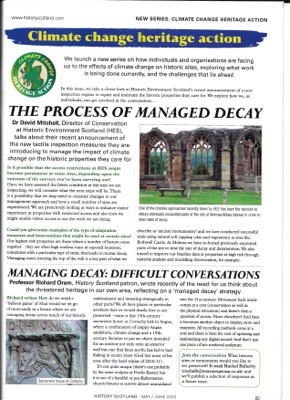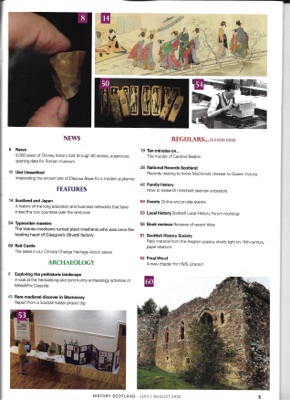Proposed activities
The main activities we would like to carry out are outlined below. Clearly there would need to be a phased, step-by-step approach over a period of time (possibly some years if an archaeological dig were to be made), and to this end a management plan and timescale is being drawn up and potential sources of funding are being explored.
Vegetation management
At the site visit in November 2019, the extent of the scrub and bushes on and around the Castle was very visible. This scrub around the Castle really needs to be cleared, not only to preserve the building itself and protect the walls from further damage, but also to reveal the line of the barmkin wall and the original footprint of castle.
According to Heritage Environment Scotland (HES), clearing scrub generally does not require scheduled monument consent (SMC) provided that no vegetation with a trunk diameter greater than 10cm is felled, and that vegetation is not cleared by burning since this can damage masonry and underlying archaeological deposits or features.
However, clearance does depend on various factors, such as the extent of the vegetation and the means of its removal. SMC is usually necessary where the proposed vegetation clearance is likely to have a subsequent effect on underlying masonry or archaeology. HES would not consent to the killing and total removal of ivy growing from masonry, for example, without a corresponding proposal to consolidate the underlying masonry as the ivy root system degrades.
If we did wish to tackle any ivy on the site, HES would advise cutting back the green/soft parts only. Leaving any woody growth and the stem system means the ivy will continue to provide any structural support that it might now be contributing to masonry, while cutting back the greenery will limit its growth. This can then allow for a more accurate assessment of the condition of any masonry, with a view to removing the ivy in its entirety before consolidating the underlying stonework.
We understand that Cawdor Estate would plan to clear the vegetation in the first place since they have the men and machinery to hand. However, they would welcome assistance from volunteers. It might be prudent, after the initial clearance, to keep the vegetation under control on a regular basis.
Conservation
We would like to do the minimum necessary to preserve the Castle’s important features and to try and ascertain more about its structure and history, given that it is virtually a unique building in Scotland - which is, of course, why it is a scheduled monument. We would not actually try to repair the castle to bring it back to its original state, though it would be sensible to try and protect the walls from further damage, ensure the structure is safe and stable (ie no stones likely to fall), and carry out any minor repairs or consolidation for conservation of important features. Such minor repairs and consolidation can be a useful way of ensuring the long-term preservation of the monument. This work, for which we would try and secure funding, would require SMC from HES.
Consolidation of masonry
One thing to be considered is the state of any walls uncovered after vegetation removal and how then best protect them. During the site visit it was observed that previous consolidation had used modern cement and other unsuitable materials. We would have to be prepared in the event of exposing standing walls to consolidate in the best way possible with experienced masonry contractors and further advice from HES. Again, we would endeavour to find the funding for this work.
In principle HES says they would welcome any proposals to consolidate masonry that is under threat. At Rait Castle there were two areas of masonry that could be identified as potentially benefitting from consolidation. These are a length of wall to the west of the hall-house that is currently overgrown with ivy, and a length of wall to the east of the hall-house that has some woody growth.
If either of these were to be consolidated (such as by repointing with an appropriate lime mortar) this would likely happen alongside vegetation removal. While light vegetation removal could be undertaken to both of these features without SMC, killing or removing vegetation from either wall entirely would put the masonry at greater risk than the vegetation itself poses. This might also be the case for other parts of masonry that might be uncovered in the undergrowth around the castle. HES would be happy to advise on consolidation proposals as things progress.
Surveys
HES is not currently aware of any surveys having been undertaken of Rait Castle (the papers mentioned above were essentially physical examinations and descriptions of the building and its structure rather than any survey of the whole area in which the Castle stands). HES says that often surveys can be a very useful initial step however, as having an accurate and detailed survey of structure can help inform subsequent proposals for years to come. Such work would not typically require SMC.
It would thus be extremely useful to undertake a survey of the Castle, outbuildings, chapel, grounds and immediate vicinity. While a simple field walk might be helpful, there are several other non-invasive types of survey which could be considered.
A standing building survey, undertaken by a professional archaeologist, would be a useful way to learn more about the monument. A detailed standing building survey has the potential to extract information about how the Castle was constructed, and what the different phases of construction were. Indeed, why was the Castle located where it is? Gervaise de Rait was Constable of Nairn Castle in the 1290s and it would appear that Rait Castle has a clear line of site with Nairn Castle, which may have some significance.
A plane table survey could be useful in understanding and interpreting any structural features that remain on the ground (eg the grass-covered lumps and bumps around the Castle). This is less common today than it once was, but can extract a lot of information when done properly. Both plane table and standing building survey would not require SMC.
Regarding other types of survey, HES states that LiDAR or photogrammetric survey of the Castle would also not require SMC. HES also notes that it could be worth exploring the possibility of undertaking a geophysical survey within the monument to learn about any sub-surface features, though a geophysical survey would require Metal and Mineral Detecting Consent (MMDC). This is similar to SMC and is also administered by HES. HES mentions that ground-penetrating radar (GPR) is exempt from MMDC and such a survey might point to some underlying earlier foundations of the Castle.
In order to carry out a proper survey, the clearance of the vegetation is the first priority since a clear line of site between two people is necessary for accurate measurement. To this end, it might be useful to eventually remove partially and/or temporarily the barbed wire fence separating the Castle from the woodland (and the rest of the Castle grounds) to facilitate access for the small survey team.
Digital reconstruction
Having read about the digital reconstruction of Flnlaggan by the University of St Andrews in a recent issue of the History Scotland magazine, I believed it would also be rewarding to undertake a digital reconstruction of Rait Castle and its environment to try and ascertain what it may have looked like in its original state.
The University of St Andrews has a certain amount of competence and experience in digital reconstruction and believes that Rait Castle seems like a fascinating site. Having taken a look at the images of the site on the Canmore database, and being present at the site visit, they think the Castle would be suitable for digital reconstruction, regardless of whether or not permission is obtained for an archaeological dig. At the very least a representation of the main part of the castle should be achievable from the surviving ruins and recent detailed drone photographs of the Castle by local Nairn resident Kenny MacLeod.
UStA would be delighted to discuss further how a project might be put together, and potential funding options. HES says that undertaking digital surveys and creating a digital reconstruction of the site would not require SMC providing no physical disturbance to the site is required. (HES believes there would be none but would be happy to advise further if there would).
Archaeological excavation
HES would consider an SMC application for a very careful and robustly designed and supervised excavation. Like any other SMC, this would need to be justified as being in the public interest, and likely to produce nationally significant results that outweigh the (albeit controlled) destruction of archaeological material through excavation. Any proposed excavation must demonstrate that it is suitably resourced, based on a detailed research strategy, and employs appropriately skilled and experienced archaeologists. Members of the Core Team do have the necessary expertise, of course.
HES recommends that exploring options for excavation is left until other means of investigation (such as surveys) have been exhausted, as the results from these would help inform how excavation might be targeted.
Experience from the University of the Highlands and Islands indicates that excavation at a castle could be very expensive - great depths of complex stratigraphy can be encountered, heightened Health & Safety concerns with standing building and deep stratigraphy, many artefacts and ecofacts being recovered - which means post excavation needs and funding can be great. UHI confirms that a conservation plan and a plan for the stabilisation or conservation of the building would need to come first. And, of course, the possibilities for grants and other sources of funding would need to be explored.
Both UHI and the University of Leicester Archaeological Services believe that Rait Castle might provide a useful venue for their archaeological students to gain practical experience in carrying out a dig. This would demonstrate that Rait Castle would have an educational function. Indeed, taking this a step further, excavation could be done as a research collaboration with the local community. An instructive example is the ruined Tarbert Castle in Argyll where a community dig was organized.
The community in Tarbert opened up access to the castle, cleared the site of alien vegetation, interpreted the ruins and successfully developed a management plan to care for the castle. The tower house was surrounded by a security fence and was in danger of complete collapse and stonework as consolidated by contractors. A desktop study and non-invasive survey of the ruins was commissioned with the intention of progressing to an archaeological dig. This work consisted of a systematic survey recording all the features and earthworks in the castle grounds, a laser survey of the castle and geophysical examination around the castle remains.
This whole project took a long time and cost a lot of money (obtained through funding) with many volunteers taking part. Of course, as Cawdor Estate has made clear, unlike Tarbert they do not want Rait Castle to be a major tourist attraction and thus opening up access would not be on the cards. But the work carried out by the Tarbert community shows what can be done and it is exactly the kind of things we would like to do at Rait to try and discover more about its history and place in the High and early Late Middle Ages in the Nairn area.


